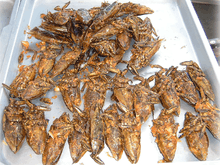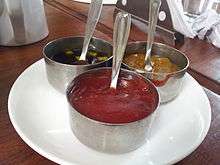Lethocerus indicus
Lethocerus indicus is a giant water bug in the family Belostomatidae, native to South and Southeast Asia, as well as southeast China the Ryukyu Islands and New Guinea.[1] It was originally described as Belostoma indicum but is no longer placed in that genus.
| Lethocerus indicus | |
|---|---|
 | |
| Lethocerus indicus | |
| Scientific classification | |
| Kingdom: | |
| Phylum: | |
| Class: | |
| Order: | |
| Family: | |
| Genus: | |
| Species: | L. indicus |
| Binomial name | |
| Lethocerus indicus (Lepeletier & Serville, 1825) | |
| Synonyms | |
|
Belostoma indicum | |
This insect is well known as an edible species in a number of different Southeast Asian cuisines. The taste of the flight muscles is often compared to sweet scallops or shrimp.
Description
L. indicus typically has a length between 6.5 and 8 cm (2.6 and 3.1 in).[1]
Research
The large size of this insect and its flight muscles and the ease of dissection makes it an excellent model organism for muscle structure with special features pertinent to the cardiac muscle. The high degree of structural order makes is possible to obtain X-ray diffraction patterns richer and more detailed than those from vertebrate striated muscle.
As food
Vietnam
The Vietnamese call this insect cà cuống. It is a highly prized food and often boiled and fried whole. The insect's essence (a pheromone produced by the male that attracts females) is harvested by collecting its liquid-producing sacs. That liquid is then placed in small glass containers. The insect is claimed to be scarce, and demand for the extract is high. Most of the cà cuống essence on the market is therefore imitation, with the actual essence fetching a high price. Cà cuống is typically used sparsely and eaten with bánh cuốn (rice noodle rolls) by adding a drop to the nước chấm (dipping sauce).
It is also eaten in a soup dish called 'bún thang' adding a unique essence to the broth. The dish traditionally includes rice noodles, thinly sliced egg crepe, pork cold cuts, and other various additions in a chicken/dry squid broth. A tiny drop of the extract on the tip of a toothpick would suffice to flavor the whole bowl of soup. This dish originated in Northern Vietnam.
Thailand
In the northeast region of Thailand, eating insects is common. In other parts of Thailand, including the Central and Southern regions, the aromatic essence from this species of insect, known as malaeng da (Thai: แมลงดา), malaeng da na (แมลงดานา) or maeng da na (แมงดานา), is also popular. The water bug can be eaten whole and fried, and as an extract.[2] Malaeng da is used to make nam phrik malaeng Da, a type of chili sauce used as a condiment.[3]
Philippines
In the Ilocos region in the northern part (Luzon) of the Philippines some insects such as crickets, locusts, and beetles are traditionally eaten. The water bug or water beetle is known as alukap in Ilokano language. It is sauteed or fried in oil, garlic, onions and tomatoes, or roasted, after the wings and legs have been removed, and eaten as a viand for steamed rice or as a finger food with liquor. The same is done in the Visayas region where it is called obus in the Visayan language.[4]
 Giant water bugs in the market. Lopburi, Thailand. |
 Fried giant water bugs. |
Nam phrik malaeng da made with crushed Lethocerus indicus. |
See also
Bibliography
- Gene DeFoliart of food-insects.com
- Bekyarova, T. I., Baumann, B. A .J., Reedy, M. C., Tregear, R. T., Ward, A., Krzic, U., Prince, K. M., Reconditi, M., Gore, D., Irving, T. C., and Reedy, M. K. "Crossbridges as Passive Brakes: Reverse Actin Sliding Triggers Strong Myosin Binding That Moves Tropomyosin"PNAS 105:10372-10377 (2008).
References
- P. J. Perez-Goodwyn (2006). Taxonomic revision of the subfamily Lethocerinae Lauck & Menke (Heteroptera: Belostomatidae)". Stuttgarter Beiträge zur Naturkunde. A (Biologie) 695: 1–71.
- http://www.thaibugs.com/edible%20insects.htm Archived 2007-10-14 at the Wayback Machine - ThaiBugs.com
- Chapter 24 SE Asia Thailand Archived 2012-02-23 at the Wayback Machine
- Chapter 25 Other Countries in SE Asia
External links

